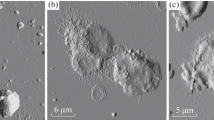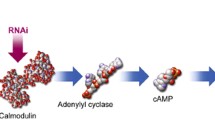Abstract
The galvanotactic response of human granulocytes was investigated theoretically and experimentally. The basic results are: (i) The granulocytes move towards the anode. (ii) The directed movement has been quantified by two different polar order parameters-the McCutcheon index and the average of cos ϕ. (iii) The polar order parameters are a function of the applied electric field (= dose-response curve). (iv) The inverse of the galvanotactic constant of migrating cells (analogous to the Michaelis-Menten constant) has a value of-0.2±0.03 V/mm. (v) The galvanotactic response of granulocytes is a non-cooperative process with a cooperativity coefficient of 1±0.2. (vi) The galvanotactic constant is a function of pH. (vii) The protein essential for the galvanotactic response is very likely a G-protein.
Similar content being viewed by others
References
Abramowitz M, Stegun IA (1964) Handbook of mathematical functions with formulas, graphs, and mathematical tables. National Bureau of Standards Applied Mathematical Series 55, pp 355
Atkins PW (1986) Physical Chemistry. Oxford University Press, Oxford, p 260
Barker AT, Jaffe LF, Vanable JW (1982) The glabrous epidermis of cavies contains a powerful battery. Am J Physiol. 242:R358-R366
Becker EL, Kanaho Y, Kermode JC (1987) Nature and functioning of the pertussis toxin-sensitive G-protein of neutrophils. Biomed Pharmacol 41:289–297
Brokaw CJ (1958) Chemotaxis of bracken spermatozoids. Implications of electrochemical orientation. J Exp Biol 35:197–213
Brokaw CJ (1959) Random and oriented movements of Bracken spermatozoids. J Cell Comp Physiol 59:95–101
Bültmann BD, Gruler H (1983) Analysis of the directed and nondirected movement of human granulocytes: influence of temperature and echo 9 virus on N-formyl methionyl leucyl phenylalanine induced chemokinesis and chemotaxis. J Cell Biol 96:1708–1716
Dryl SA (1963) Contribution to mechanism of chemotactic response on Paramecium caudatum. Anim Behav 11:393–396
Fromherz P (1988) Selforganization of the fluid mosaic of charged channel proteins in membranes. Proc Natl Acad Sci USA 85:6353–6357
Fukushima K, Senda N, Innui H, Mirua H, Tamai Y, Murakami Y (1953) Studies on galvanotaxis of leukocytes. Med J Osaka Univ 4:195–208
Gooday GW (1981) Chemotaxis in eukaryontic microbes. In: Lackie JM, Wilkinson PC (eds) Biology of the chemotactic response. Society for Experimental Biology. Seminar Series, vol 12. Cambridge University Press, London, pp 115–138
Gruler H (1984) Cell movement analysis in necrotactic assay. Blood Cells 10:107–122
Gruler H (1988a) Cell movement and symmetry of the cellular environment. Z Naturforsch 43c, 754–764
Gruler H, (1988b) Biophysics of leukocytes: Neutrophil chemotaxis, characteristics and mechanisms. In: Hallet MB (ed) The cellular biochemistry and physiology of neutrophil. CRC Press, Boca Raton, Florida
Gruler H, Bültmann BD (1984a) Analysis of cell movement, Blood Cells 10:61–77
Gruler H, Bültmann B (1984 b) Virus-induced order-disorder transition of moving human leukocytes. Nuovo Cimento (Suppl) 3 D:152–173
Gruler H, Nuccitelli R (1986) New insights into galvanotaxis and other directed cell movements: an analysis of the translocation distribution function. In: Nuccitelli R (ed) Ionic currents in development. Alan R Liss, New York, pp 337–347
Haken H (1983) Synergetics. Nonequilibrum phase transitions and self-organization in physics, chemistry, and biology. Springer, Berlin Heidelberg New York
Hille B (1984) Ionic channels of excitable membranes. Sinauer, Sunderland, MA
Lauffenburger D, Rothman C, Zigmond SH (1983) Measurement of leukocyte motility and chemotaxis parameters with a linear under-agarose migration assay. J Immunol 131:940–947
Lehninger AL (1975) Biochemistry. Worth, New York
Malvista SE, de Boisfleury-Chevance A (1982) The cytokineplast: purified, stable and functional machinery from human blood polymorphonuclear leukocytes. J Cell Biol 95:960–973
Nuccitelli R (1983) Transcellular ion currents: Signals and effectors of cell polarity. Mod Cell Biol 2:451–481
Snyderman R (1983) Pharmacologic manipulation of leukocyte chemotaxis. Present knowledge and future trends. Am J Med 31:10–18
Stryer L, Bourne HRG (1986) G-proteins: a family of signal transducers. Annu Rev Cell Biol 2:391–419
Zigmond SH (1977) Ability of polymorphonuclear leukocytes to orient in gradients of chemotactic factors. J Cell Biol 75:606–616
Author information
Authors and Affiliations
Rights and permissions
About this article
Cite this article
Rapp, B., de Boisfleury-Chevance, A. & Gruler, H. Galvanotaxis of human granulocytes. Eur Biophys J 16, 313–319 (1988). https://doi.org/10.1007/BF00254068
Received:
Accepted:
Issue Date:
DOI: https://doi.org/10.1007/BF00254068




